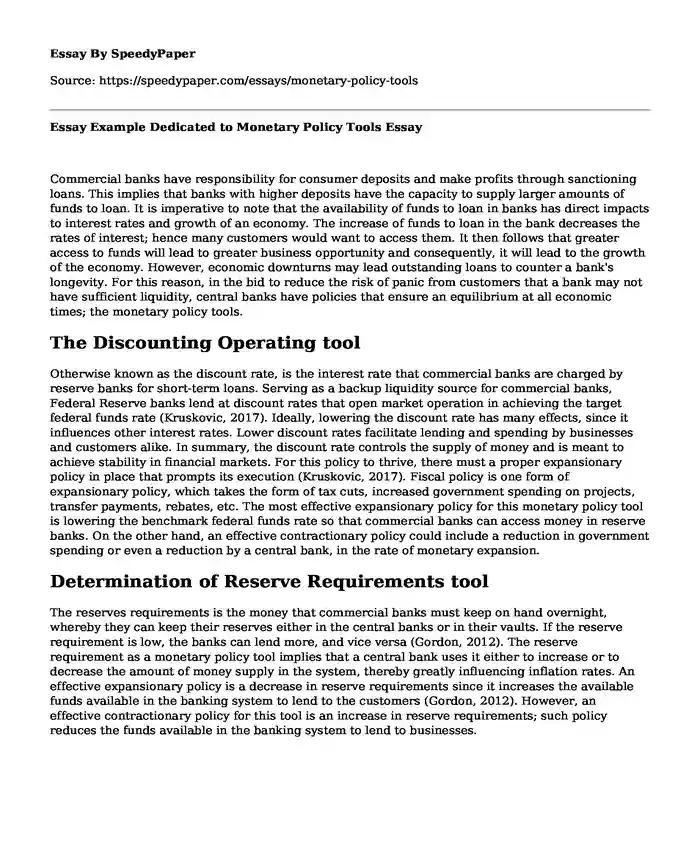Commercial banks have responsibility for consumer deposits and make profits through sanctioning loans. This implies that banks with higher deposits have the capacity to supply larger amounts of funds to loan. It is imperative to note that the availability of funds to loan in banks has direct impacts to interest rates and growth of an economy. The increase of funds to loan in the bank decreases the rates of interest; hence many customers would want to access them. It then follows that greater access to funds will lead to greater business opportunity and consequently, it will lead to the growth of the economy. However, economic downturns may lead outstanding loans to counter a bank's longevity. For this reason, in the bid to reduce the risk of panic from customers that a bank may not have sufficient liquidity, central banks have policies that ensure an equilibrium at all economic times; the monetary policy tools.
The Discounting Operating tool
Otherwise known as the discount rate, is the interest rate that commercial banks are charged by reserve banks for short-term loans. Serving as a backup liquidity source for commercial banks, Federal Reserve banks lend at discount rates that open market operation in achieving the target federal funds rate (Kruskovic, 2017). Ideally, lowering the discount rate has many effects, since it influences other interest rates. Lower discount rates facilitate lending and spending by businesses and customers alike. In summary, the discount rate controls the supply of money and is meant to achieve stability in financial markets. For this policy to thrive, there must a proper expansionary policy in place that prompts its execution (Kruskovic, 2017). Fiscal policy is one form of expansionary policy, which takes the form of tax cuts, increased government spending on projects, transfer payments, rebates, etc. The most effective expansionary policy for this monetary policy tool is lowering the benchmark federal funds rate so that commercial banks can access money in reserve banks. On the other hand, an effective contractionary policy could include a reduction in government spending or even a reduction by a central bank, in the rate of monetary expansion.
Determination of Reserve Requirements tool
The reserves requirements is the money that commercial banks must keep on hand overnight, whereby they can keep their reserves either in the central banks or in their vaults. If the reserve requirement is low, the banks can lend more, and vice versa (Gordon, 2012). The reserve requirement as a monetary policy tool implies that a central bank uses it either to increase or to decrease the amount of money supply in the system, thereby greatly influencing inflation rates. An effective expansionary policy is a decrease in reserve requirements since it increases the available funds available in the banking system to lend to the customers (Gordon, 2012). However, an effective contractionary policy for this tool is an increase in reserve requirements; such policy reduces the funds available in the banking system to lend to businesses.
Open Market Operations (OMO) tool
The OMO refers to buying and selling government securities in an open market, as a way of controlling the amount in the banking system (Carlson & Lackman, 2017). Ideally, the purchase of securities increases the amount of money in the system, while selling decreases the amount of money in the banking system. An effective expansionary policy of the tool is when the government or the central bank buys securities, while an effective contractionary policy is when securities are sold.
References
Carlson, W., & Lackman, C. (2017). Raising interest rates: IOER vs. OMO: Interest on excess reserves vs open market operations. International Journal Of Financial Research, 9(1), 142. doi: 10.5430/ijfr.v9n1p142
Gordon, D. (2012). The Federal Reserve banks new monetary policy tool. Journal Of Business & Economics Research (JBER), 10(9), 533. doi: 10.19030/jber.v10i9.7193
Kruskovic, B. (2017). Exchange rate and interest rate in the monetary policy reaction function. Journal Of Central Banking Theory And Practice, 6(1), 55-86. doi: 10.1515/jcbtp-2017-0004
Cite this page
Essay Example Dedicated to Monetary Policy Tools. (2022, Sep 26). Retrieved from https://speedypaper.com/essays/monetary-policy-tools
Request Removal
If you are the original author of this essay and no longer wish to have it published on the SpeedyPaper website, please click below to request its removal:
- How Does the Dabbawala System Work? Free Essay Sample
- Free Essay Sample about Traveling
- Free Essay Example on Adolescence Eating Habits
- The Issues of Cohabitation
- Free Essay on How Advertising Today Reinforces Racism and Racist Stereotypes
- Free Paper with Articles Review on African Women's History
- Paper Example. the American Setting of Citizenship Approach
Popular categories





